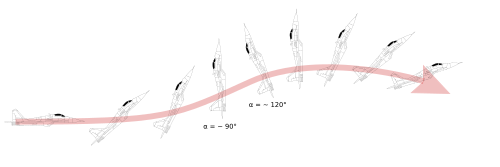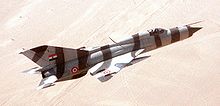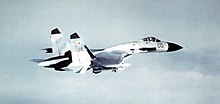
The Saab 37 Viggen is a single-seat, single-engine multirole combat aircraft designed and produced by the Swedish aircraft manufacturer Saab. It was the first canard-equipped aircraft to be produced in quantity and the first to carry an airborne digital central computer with integrated circuits for its avionics, arguably making it the most modern/advanced combat aircraft in Europe at the time of introduction. The digital central computer was the first of its kind in the world, automating and taking over tasks previously requiring a navigator/copilot, facilitating handling in tactical situations where, among other things, high speeds and short decision times determined whether attacks would be successful or not, a system not surpassed until the introduction of the Panavia Tornado into operational service in 1981.

A leading-edge extension (LEX) is a small extension to an aircraft wing surface, forward of the leading edge. The primary reason for adding an extension is to improve the airflow at high angles of attack and low airspeeds, to improve handling and delay the stall. A dog tooth can also improve airflow and reduce drag at higher speeds.
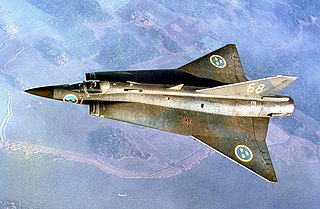
The Saab 35 Draken is a Swedish fighter-interceptor developed and manufactured by Svenska Aeroplan Aktiebolaget (SAAB) between 1955 and 1974. Development of the Saab 35 Draken started in 1948 as the Swedish air force future replacement for the then also in development Saab 29 Tunnan dayfighter and Saab 32B Lansen night fighter. It featured an innovative but unproven double delta wing, which led to the creation of a sub-scale test aircraft, the Saab 210, which was produced and flown to test this previously-unexplored aerodynamic feature. The full-scale production version entered service with frontline squadrons of the Swedish Air Force on 8 March 1960. It was produced in several variants and types, most commonly as a fighter-interceptor.

The fourth-generation fighter is a class of jet fighters in service from around 1980 to the present, and represents design concepts of the 1970s. Fourth-generation designs are heavily influenced by lessons learned from the previous generation of combat aircraft. Third-generation fighters were often designed primarily as interceptors, being built around speed and air-to-air missiles. While exceptionally fast in a straight line, many third-generation fighters severely lacked in maneuverability, as doctrine held that traditional dogfighting would be impossible at supersonic speeds. In practice, air-to-air missiles of the time, despite being responsible for the vast majority of air-to-air victories, were relatively unreliable, and combat would quickly become subsonic and close-range. This would leave third-generation fighters vulnerable and ill-equipped, renewing an interest in manoeuvrability for the fourth generation of fighters. Meanwhile, the growing costs of military aircraft in general and the demonstrated success of aircraft such as the McDonnell Douglas F-4 Phantom II gave rise to the popularity of multirole combat aircraft in parallel with the advances marking the so-called fourth generation.
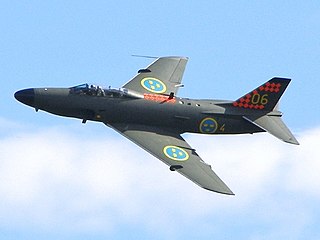
The Saab 32 Lansen is a two-seat, transonic military aircraft designed and manufactured by the Swedish aircraft manufacturer Saab AB.

The Rockwell-Messerschmitt-Bölkow-Blohm X-31 is an experimental jet aircraft designed to test fighter thrust vectoring technology.

The Sukhoi Su-37 was a single-seat twin-engine aircraft designed by the Sukhoi Design Bureau which served as a technology demonstrator. It met the need to enhance pilot control of the Su-27M, a further development of the Su-27. The sole example built was originally the eleventh Su-27M (T10M-11) built by the Komsomolsk-on-Amur Aircraft Production Association before having thrust-vectoring nozzles installed. It also had updated flight- and weapons-control systems. The aircraft made its maiden flight in April 1996. Throughout the flight-test program, the Su-37 demonstrated its supermaneuverability at air shows, performing manoeuvres such as a 360-degree somersault. The aircraft crashed in December 2002 due to structural failure. The Su-37 did not enter production, despite a report in 1998 which claimed that Sukhoi had built a second Su-37 using the twelfth Su-27M airframe, T10M-11 remained the sole prototype. Sukhoi had instead applied the aircraft's systems to the design bureau's other fighter designs.
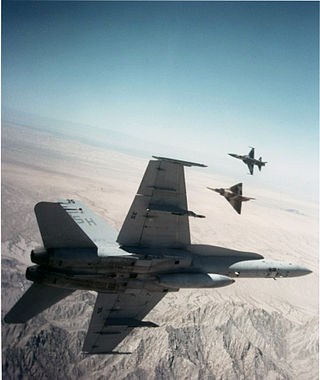
Air combat manoeuvring (ACM) is the tactic of moving, turning, and situating one's fighter aircraft in order to attain a position from which an attack can be made on another aircraft. Commonly associated with dogfighting, air combat manoeuvres rely on offensive and defensive basic fighter manoeuvring (BFM) to gain an advantage over an aerial opponent.

Aerobatic maneuvers are flight paths putting aircraft in unusual attitudes, in air shows, dogfights or competition aerobatics. Aerobatics can be performed by a single aircraft or in formation with several others. Nearly all aircraft are capable of performing aerobatics maneuvers of some kind, although it may not be legal or safe to do so in certain aircraft.

Basic fighter maneuvers (BFM) are tactical movements performed by fighter aircraft during air combat maneuvering, to gain a positional advantage over the opponent. BFM combines the fundamentals of aerodynamic flight and the geometry of pursuit, with the physics of managing the aircraft's energy-to-mass ratio, called its specific energy.

The Saab 210 is an approximately 70% scale research prototype for the double-delta configuration of the Saab 35 Draken supersonic fighter. It became known by the unofficial nickname Lilldraken. Its first flight was on 21 January 1952.
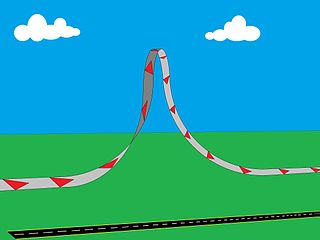
A barrel roll is an aerial maneuver in which an airplane makes a complete rotation on both its longitudinal and lateral axes, causing it to follow a helical path, approximately maintaining its original direction. It is sometimes described as a "combination of a loop and a roll". The g-force is kept positive on the object throughout the maneuver, commonly between 2 and 3g, and no less than 0.5g. The barrel roll is commonly confused with an aileron roll.
The scissors is an aerial dogfighting maneuver commonly used by military fighter pilots. It is primarily a defensive maneuver, used by an aircraft that is under attack. It consists of a series of short turns towards the attacking aircraft, slowing with each turn, in the hopes of forcing the attacker to overshoot. Performed properly, it can cause the attacking aircraft to move far enough in front to allow the defender to turn the tables and attack.
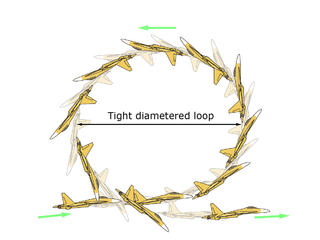
The "Kulbit" is an aerial maneuver developed by Russian pilots in which the aircraft performs an extremely tight loop, often not much wider than the length of the aircraft itself. It differs from the traditional inside loop as it uses post-stall maneuvering capabilities, a type of supermaneuverability. Like most post-stall maneuvers, it demonstrates pitch control outside the normal flight envelope wherein pitch control is made possible by having aerodynamic flow over the aircraft's elevators or stabilators.
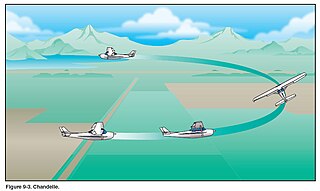
The chandelle is an aircraft control maneuver where the pilot combines a 180° turn with a climb.
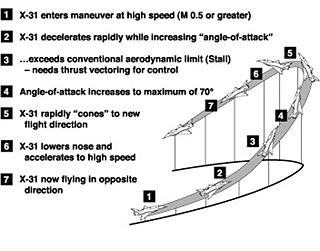
The Herbst maneuver is an air combat maneuver that uses post-stall technology such as thrust vectoring and advanced flight controls to achieve high angles of attack. The Herbst maneuver allows an aircraft to quickly reverse direction using a combination of high angle-of-attack and rolling. Though categorized with Pugachev's Cobra, which is popular at airshows, the Herbst maneuver is considered more useful in combat.
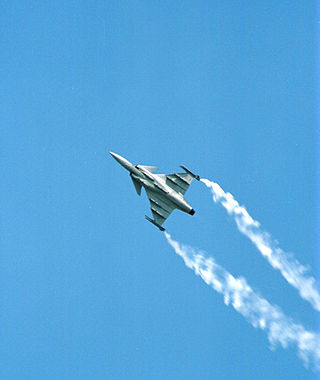
The JAS 39 Gripen is a fighter aircraft manufactured by the Swedish aerospace company Saab.
Supermaneuverability is the capability of fighter aircraft to execute tactical maneuvers that are not possible with purely aerodynamic techniques. Such maneuvers can involve controlled side-slipping or angles of attack beyond maximum lift.
3D Aerobatics or 3D flying is a form of flying using flying aircraft to perform specific aerial maneuvers. They are usually performed when the aircraft had been intentionally placed in a stalled position for purposes of entertainment or display. They are also often referred to as post-stall maneuvers, as they occur after aerodynamic stall has occurred and standard control surface deflections, as used in flight, are not effective.
A wingover is an aerobatic maneuver in which an airplane makes a steep climb, followed by a vertical flat-turn. The maneuver ends with a short dive as the plane gently levels out, flying in the opposite direction from which the maneuver began.


